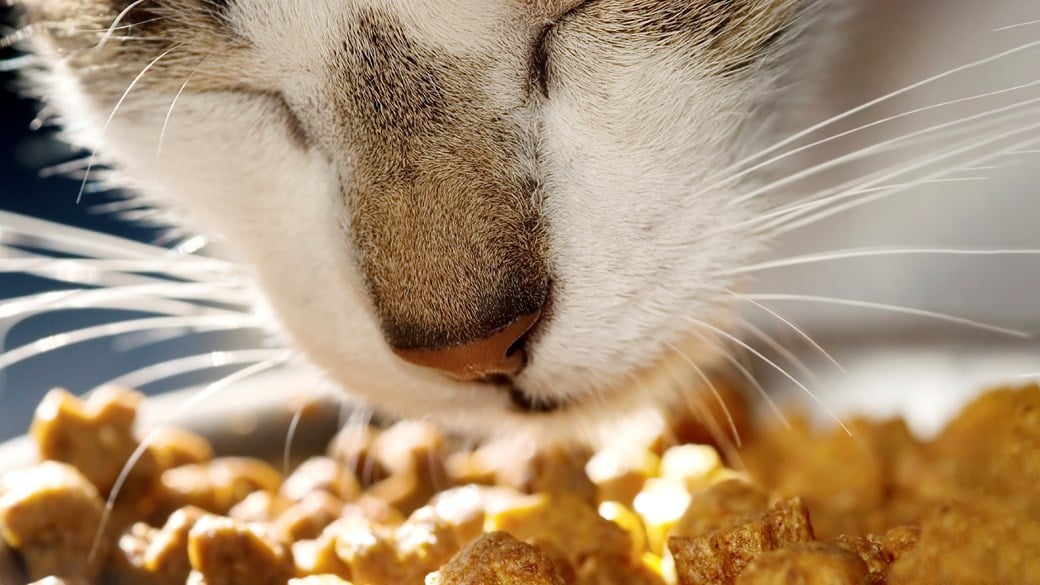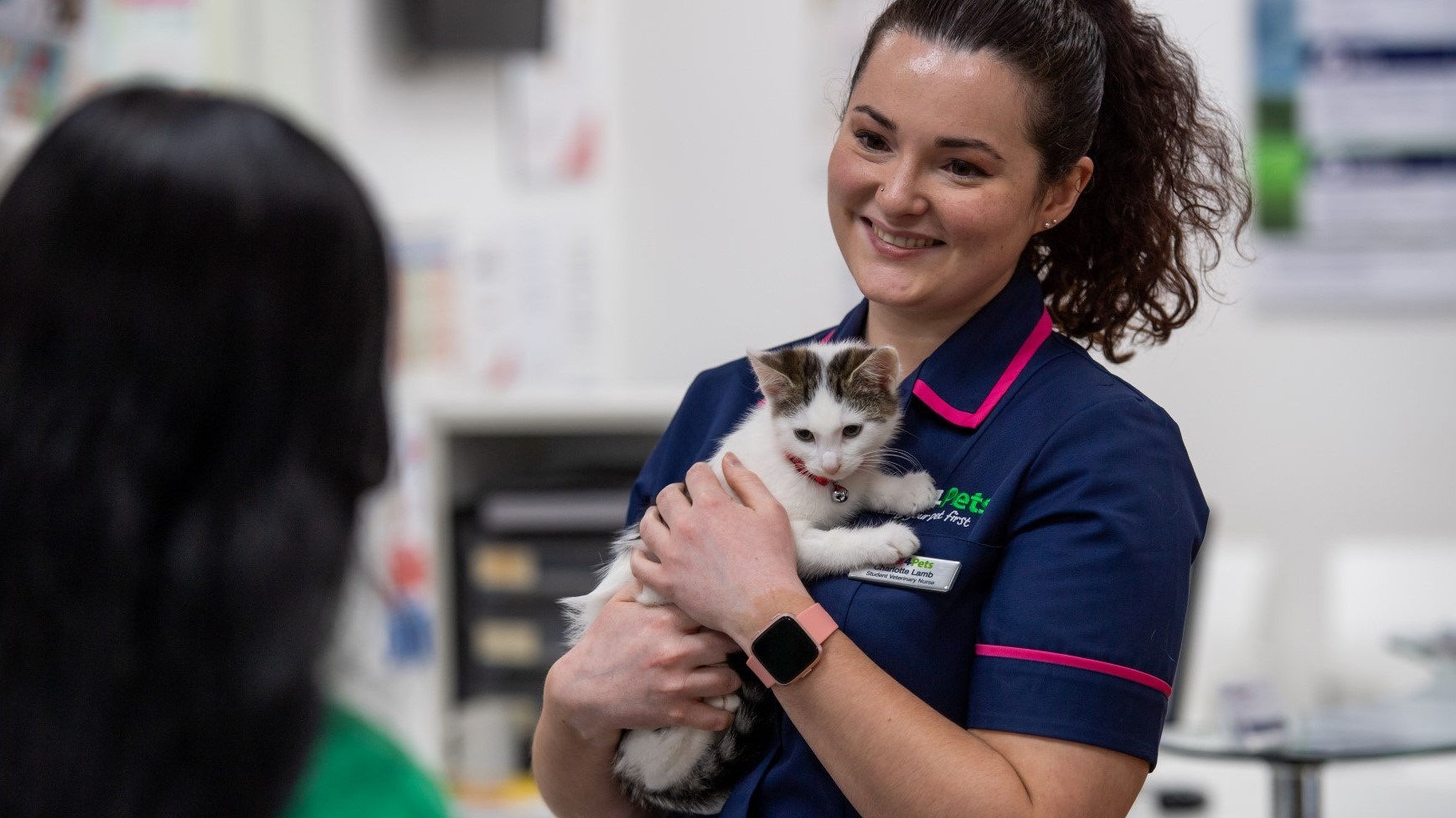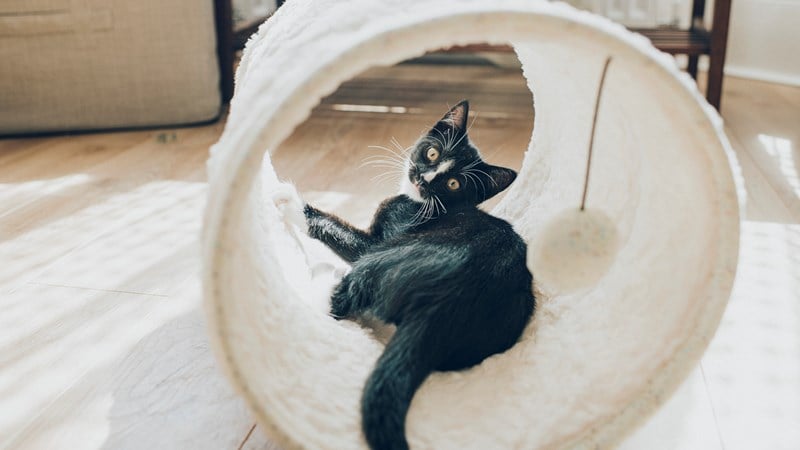
Transitioning Your Kitten To An Adult Cat Diet
Your kitten is growing fast and it will soon be time to think about the transition from feeding them as a kitten, to feeding them as a young adult cat.
Read our guide below to making the change to an adult diet and help your kitten to grow into a happy and healthy adult cat.
What are the important things to think about when feeding cats for health and wellbeing?
As your kitten grows into adolescence and adulthood, it’s a good idea to review their nutrition and feeding in order to give them the best chance of a happy and healthy life.
There are three main things on which we can focus:
- We want to continue to provide the essential nutrients, in the correct balance, for your cat’s lifestage
- We need to promote and maintain a healthy adult body composition and body condition score
- We need to satisfy your cat’s behavioural needs
Your kitten will have been used to eating wet or dry kitten food, and it’ll be time to introduce a diet designed for young adult cats at around 12 months of age. Kitten food is more calorie-dense than adult food and staying on it once your kitten has completed their growing, especially once they’ve been neutered, means that they’ll begin to put on excess bodyweight, which is better avoided.
You’ll already know what sort of foods your kitten prefers to eat, so it should be easy to choose an equivalent adult diet for them. Many cats like to eat both wet and dry food. If you offer wet food, remember that cats like their food to be very fresh, so consider a smaller pouch or tin size and only put out enough wet food for them to eat at the next sitting, so it doesn’t start to go off. There’s no need to rush the transition to adult food – some cats can be very fussy about changes to their diet! When you want to introduce the new food, the easiest way is to offer a tiny amount in a dish close to your kitten’s usual food bowl. This way, they won’t go hungry if they don’t yet want to try the new food, but they will be able to explore it when they’re ready. Once your kitten is happily trying the new food, you can gradually increase the amount you offer, while reducing the kitten food.
Some diets are aimed specifically at neutered cats, and others at young adults, while some are more general. Just as when you were choosing kitten food, go for the best quality you can afford. Pick an adult diet that is high in good quality, animal-derived protein. Cats require a higher level of protein in their diet than most other species do, as they get a large amount of their energy from digesting it. Cats are also obligate carnivores, which means that, unlike dogs, who are omnivores, they must eat meat in order to obtain the specific nutrients they need.
Not only do cats require high levels of dietary protein, but they also require very good quality protein that contains specific amino acids, the building blocks of protein. Two different diets may state on the label that they contain the same level of protein, but the quality of that protein and its digestibility are normally reflected in the price. Some diets also contain ingredients designed to assist with dental or urinary tract health and these are also good things to look for.
Nowadays, pet obesity is a hot topic. According to the Pet Food Manufacturers’ Association Obesity Report 2019, vets estimated that 44 per cent of cats were suffering from obesity.
Although social media has led us to believe that overweight pets are cute, cuddly or amusing, pet obesity is a significant animal welfare issue. Some of the health problems associated with being overweight include diabetes, liver disease, arthritis, bladder disease, respiratory difficulties and cancer, so it’s really important we take care of our cats by keeping them slim from the outset.
Simply put, if a cat is eating up more calories than they’re using, they will store body fat and gain weight. In most cases, you can control exactly what and how much your cat eats, so if they’re receiving an appropriate diet in the right quantities and their activity levels are normal for their age, they should be able to stay at a healthy weight. Sometimes, cats will have other opportunities to eat: if they go out, they may supplement their diet by hunting.
Hunting is a normal behavioural need in cats, even those who are not hungry. Also, some cats may become friendly with neighbours, who may feel they’re being kind to them by giving them food. Cats may help themselves to each other’s food in a multi-cat household, especially if one cat is greedier than another!
Cats stop eating when they feel full, but if they get used to eating large quantities of food at a time, their stomachs adapt to being stretched and don’t send signals to the brain to stop eating as quickly as they used to do. This can lead to cats eating more and more in one go before they feel full enough to stop. Obesity can lead to decreased energy levels and reduced activity which, in turn, leads to more weight gain. It’s a vicious cycle that is far better avoided from the beginning.
Every time your cat meets your vet team, they’ll be checked for body condition score – a way of determining whether a pet is too thin, overweight or just right.
If a cat is overweight, it’s not simply a case of drastic food reduction. In fact, when overweight cats go without food, it can lead to a serious liver condition. If you have any concerns about whether your cat is over- or even underweight, have a chat with your vet team.
As a rule, if you use the feeding guide on the food packaging as just that – a guide – and monitor your cat’s body shape using online charts or by routine checks with your vet team, you can make little changes to the amount or type of food your cat is eating. Cats tend to do best if you give them small, frequent meals, just as though they were hunting and catching small prey throughout the day.
Cats are designed to be solitary hunters. They have to work hard to catch their prey, which usually consists of small mammals and birds. Cats used to be owned primarily to keep vermin down, so most of the cats we live with today have retained a strong behavioural need to hunt, whether they’re hungry or not. Left to their own devices, cats will spend up to12 hours a day hunting, although all their effort is only thought to result in success and a small meal in fewer than 50 percent of hunting attempts.
Given freedom to choose how they spend their time, well-fed pet cats are thought only to spend around three hours per day hunting and they may not kill or eat their prey if they’re not hungry when they catch it.
Apart from all the free food we provide for our cats leading to the potential for weight gain, we also remove the need to go through the motions of hunting. In addition, we tend to offer food in a small number of larger servings throughout the day, which is quite different to the way in which cats are designed to eat.
Common questions
Many people like to give their cats treats, as they want to do something to make their pet happy and strengthen the bond between them. Treats are fine in moderation, as long as they’re appropriate to the age of the cat and they are fed at or below the recommended quantities.
Too many treats not only can they lead to weight gain, but they may also trigger an upset tummy. Most treats are ‘complementary’ pet foods and shouldn’t make up a large proportion of the daily food intake. Bonding with your growing cat by playing with them, grooming them and providing a warm lap when they want to snuggle in are great ways to treat them without any risk of overdoing it!
Although most cats would probably be very pleased to be offered a saucer of milk or cream, they don’t need to drink milk once they’ve been weaned and they gradually stop making the enzymes to be able to digest it. Also, milk and cream add to calorie intake and can contribute to weight gain.
It’s really important that cats have free access to fresh water. Some cats are really fussy about drinking from a bowl, so drinking bowls need to be kept really clean and you might need to try a few different bowls before you find the type your cat prefers. Cats don’t usually like their whiskers to touch the sides of food or water bowls, so you may want to try a wide one. That said, lots of cats will drink from their owners’ own water in a glass! Cats don’t like their water to become tainted with other flavours, so it’s best to offer their water and food in separate places. They often prefer glass, metal or ceramic bowls, rather than plastic ones, possibly for the same reason.
Some cats prefer to drink from dripping taps or flowing water and seem to enjoy playing with their water. You can try offering your cat water from a dripping tap or you could leave a small amount of water as a puddle in the sink or shower. You can also buy special water fountains for cats.
Many cats prefer rainwater to tap water, so you could also collect rainwater outside and offer that to your cat, as long as it’s been collected in something clean.
The right amount of a good quality diet, plus access to clean water and plenty of opportunities for play should help your growing kitten stay healthy and happy as they grow up!
Cats who have access to the outdoors may hunt, so they’re burning calories by being active, satisfying a behavioural need and perhaps eating some or all of their prey. Whether or not your cat spends lots of time outdoors, you can help to provide some opportunities to work for food by adapting the way in which you feed them. Puzzle feeders are a wonderful way to provide your cat with a chance to work for food. They get some emotional satisfaction when they obtain their food reward and they receive small amounts of food at any one time, which is more suited to their digestion and physiology than two or three large meals a day would be.
Puzzle feeders come in all shapes and sizes, or you can even make your own. International Cat Care has some great advice about using and making puzzle feeders that your growing cat could really enjoy using! If you opt not to use a puzzle feeder, then you could split your cat’s daily food ration into about five small portions and offer these at different times of the day and perhaps in different locations. This way, your cat has to exercise to get to their meals and never eats so much in one go that they become used to being very full before they stop eating.
By adapting the way you feed your growing cat in order to take into account their nutritional and behavioural needs, you’ll be helping them to live a healthy, fit, happy life!
Health Plans to keep your kitten healthy
At Vets4Pets we offer a range of Health Plans that make essential routine treatments more affordable. You'll save money on things like annual vaccinations, flea and worm treatment and routine health check-ups.

Join our free Kitten club
Join the club for expert advice and tailored offers, including £30 off our Complete Care Health Plans

Puppy & Kitten Advice
Giving your pet the best start in life begins with getting the best expert advice.
